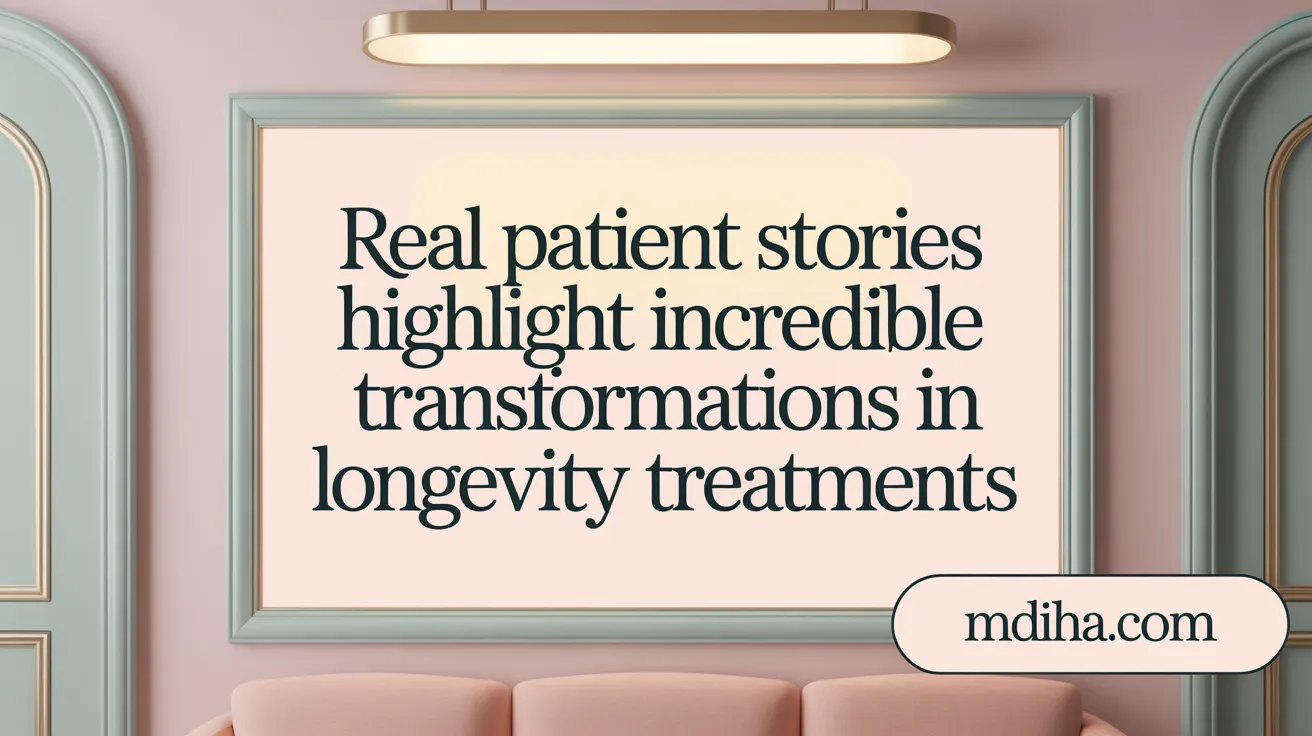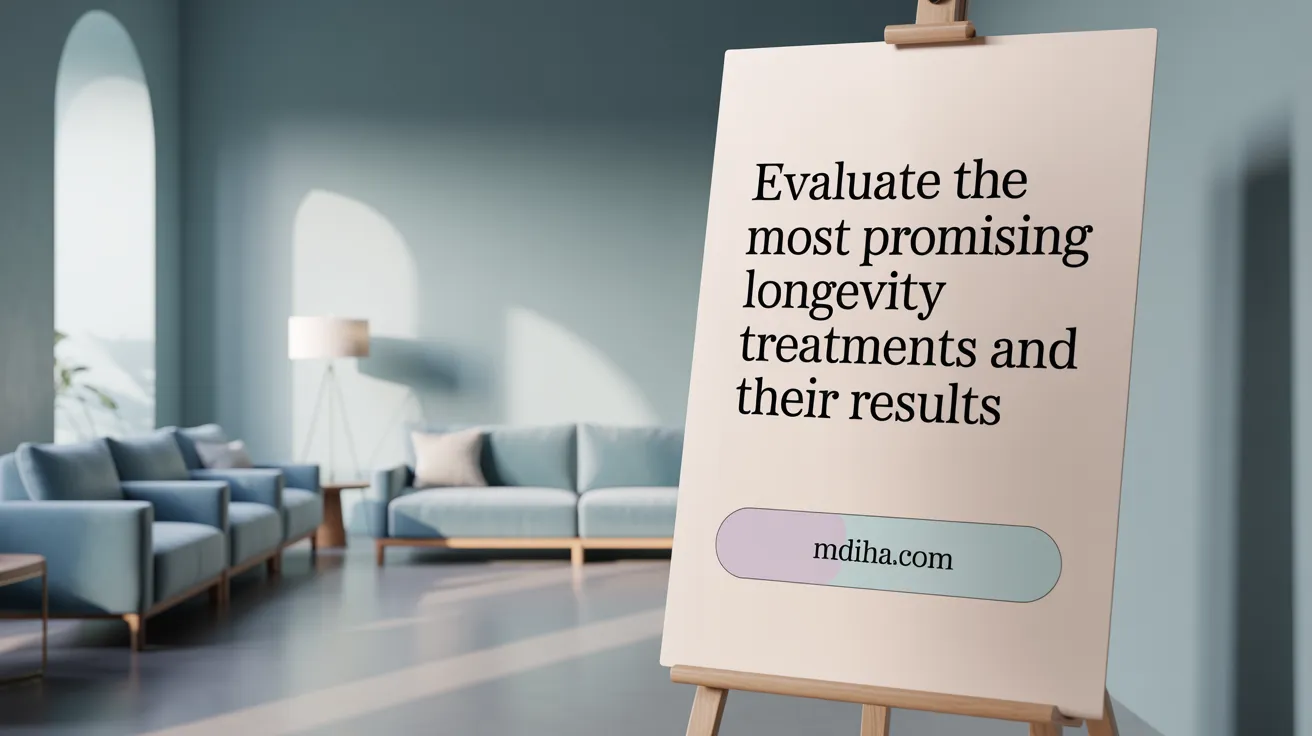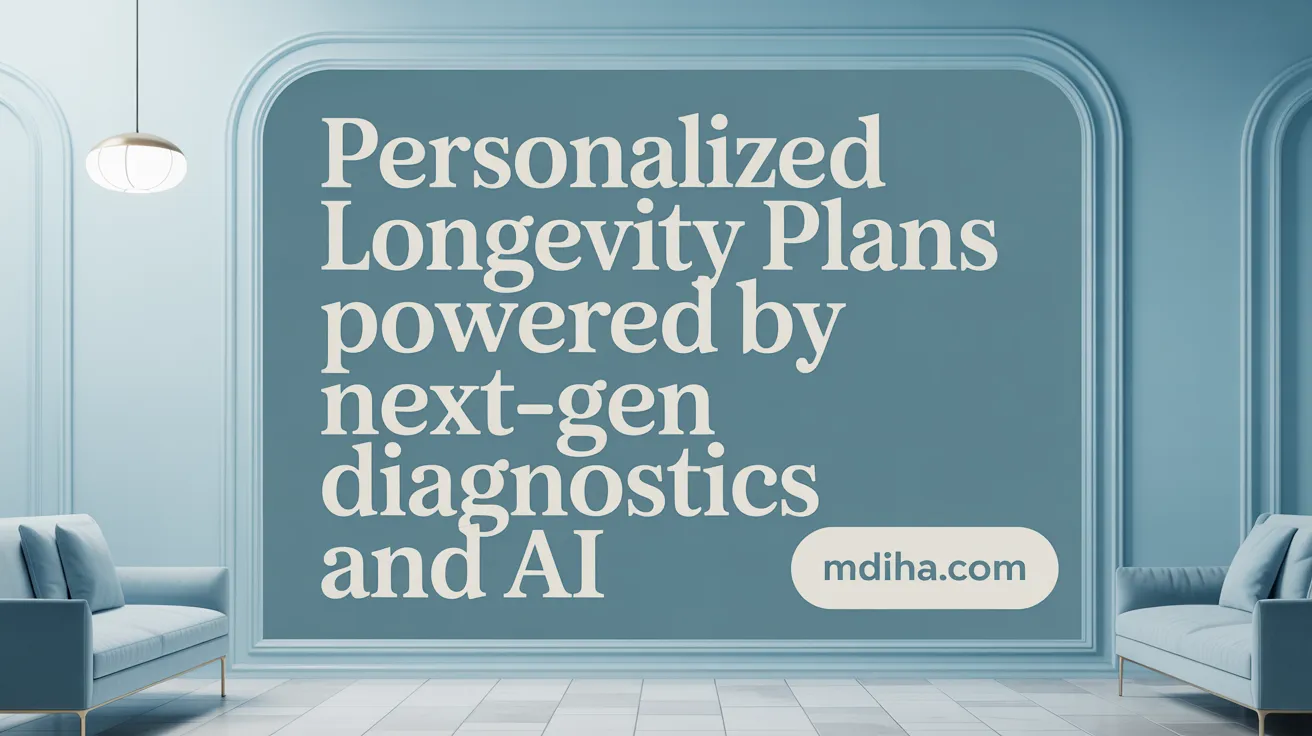Exploring the Intersection of Patient Stories and Cutting-Edge Science
As longevity medicine rapidly evolves, patients worldwide are accessing new treatments designed to extend both lifespan and healthspan. This article delves into authentic patient experiences alongside recent scientific advancements, providing a comprehensive overview of the real-world impact and emerging technologies shaping the future of anti-aging therapies.
Patient Experiences: Transformative Outcomes with Advanced Longevity Therapies

What types of patient experiences, testimonials, and outcomes have been reported with cutting-edge longevity treatments?
Patients engaging with advanced longevity therapies have reported remarkable improvements in various aspects of their health and well-being. Many describe feeling more energetic, with some experiencing a significant boost in vitality that allows them to perform physical activities they previously could not. Relief from chronic symptoms such as fatigue, pain, and anxiety is frequently noted, often after treatments like ozone therapy or holistic approaches involving detoxification and personalized supplements. For detailed patient stories, see Patient Testimonials on hormone replacement therapy and Patient Testimonials on Longevity and Wellness Treatments.
Sleep quality has improved for many patients, with fewer nighttime disturbances and hot flashes, especially among those undergoing hormone replacement therapy (HRT). Women going through menopausal symptoms report a noticeable reduction in hot flashes and night sweats, enhancing overall rest and daily functioning.
A number of individuals have experienced weight loss, which they attribute to personalized nutrition plans and mitochondrial optimization therapies. One notable testimonial includes a woman, Monica, aged 58, who struggled with chronic fatigue and weight gain. After a comprehensive health analysis and implementing a biomarker-guided personalized longevity plan—covering mitochondrial support, dietary modifications, and heavy metal detoxification—she experienced significant boosts in energy levels, mental clarity, and overall health. Read more about Monica's case study and personalized longevity plan.
Patients also report improvements in mental health, including increased focus and cognitive clarity, thanks to targeted interventions like NAD+ infusions and neuroprotective therapies such as Wavi brain scan technology for early neurodegenerative disease detection. These positive outcomes underscore the potential of combining diagnostics, regenerative strategies, and personalized care in achieving transformative health benefits.
Comprehensive evaluations and advanced diagnostics, like those available at Sheba's Longevity Center, support the development of individualized longevity care plans that optimize healthspan and target pathological aging processes.
Overall, real-world patient experiences highlight not only symptom relief but also a renewed sense of vitality, contributing to healthier aging and greater quality of life with cutting-edge longevity treatments. For more about what luxury longevity clinics offer and patient experiences, refer to New York Times’ feature on longevity clinics.
For further insights, searching “Patient testimonials cutting-edge longevity therapy outcomes” can provide a broader understanding of these transformative experiences.
Scientific Advances Driving Longevity Therapeutics
 Recent breakthroughs in aging research are transforming the landscape of longevity therapeutics. One of the most notable developments is the advent of senolytic drugs and senescent cell removal like dasatinib and quercetin, which have been shown to selectively eliminate senescent cells that contribute to tissue inflammation, degeneration, and age-related diseases. Studies led by Dr. James L. Kirkland have demonstrated that removing these cells can significantly improve healthspan and extend healthy lifespan in animal models.
Recent breakthroughs in aging research are transforming the landscape of longevity therapeutics. One of the most notable developments is the advent of senolytic drugs and senescent cell removal like dasatinib and quercetin, which have been shown to selectively eliminate senescent cells that contribute to tissue inflammation, degeneration, and age-related diseases. Studies led by Dr. James L. Kirkland have demonstrated that removing these cells can significantly improve healthspan and extend healthy lifespan in animal models.
Another promising area is epigenetic reprogramming , particularly through the use of Yamanaka factors, which can reverse cellular aging markers and restore youthful gene expression profiles. Companies like Rejuvenate Bio and Altos Labs are pioneering gene therapy approaches that utilize partial epigenetic reprogramming to extend lifespan and enhance tissue regeneration.
Metabolic modulators such as NAD+ boosters—namely nicotinamide riboside (NR) and nicotinamide mononucleotide (NMN)—are actively researched for their ability to support mitochondrial health and cellular energy production, crucial factors in aging. These therapies aim to replenish declining NAD+ levels seen in older individuals, thereby promoting DNA repair and metabolic health.
Additionally, drugs like rapamycin and metformin are undergoing clinical trials to assess their potential to retard biological aging processes. Rapamycin, an mTOR inhibitor, has been shown to stabilize energy metabolism and improve lifespan in mice, while metformin is investigated for its anti-inflammatory and metabolic benefits in humans.
To objectively measure treatment success, researchers have developed DNA methylation clocks , which use patterns of DNA methylation at specific sites to estimate biological age accurately. These biomarkers allow scientists to evaluate the efficacy of anti-aging interventions and tailor personalized treatments.
Collectively, these scientific advances are supported by preclinical and clinical evidence, underscoring a promising future where aging may be slowed, reversed, or otherwise managed to extend healthful years of life.
Mechanisms Behind Cutting-Edge Longevity Treatments

How do various cutting-edge longevity treatments work at the scientific level?
Modern anti-aging therapies are designed to target the core biological processes that underlie aging. One significant approach involves the elimination of senescent cells using senolytics, such as dasatinib and quercetin, which help reduce tissue inflammation and improve organ function.
Another focus is on restoring cellular energy metabolism. NAD+ boosters, including nicotinamide riboside (NR) and nicotinamide mononucleotide (NMN), replenish declining NAD+ levels in aging cells, enhancing mitochondrial function, improving DNA repair, and supporting cellular vitality.
Caloric restriction mimetics, like rapamycin, influence nutrient sensing pathways such as mTOR. These drugs help modulate the aging process by reducing cellular growth signals, thus enhancing autophagy and reducing metabolic damage.
Stem cell therapies and regenerative approaches are also central, aiming to replace or repair damaged tissues. These include the use of mesenchymal stem cells and exosome therapies that stimulate tissue regeneration and restore cellular function.
Gene editing technologies, like CRISPR, are used to correct genetic mutations associated with aging and age-related diseases. They enable precise modifications to improve genomic stability and potentially extend lifespan.
All these interventions address the hallmarks of aging—telomere shortening, mitochondrial decline, DNA damage, cellular senescence, and chronic inflammation—by intervening at the molecular level to promote healthy aging and increase healthspan.
Comparing Advanced Longevity Therapies: Application and Outcomes
 Several cutting-edge treatments are emerging in the longevity field, each with distinct applications and potential benefits.
Several cutting-edge treatments are emerging in the longevity field, each with distinct applications and potential benefits.
Gene editing, such as CRISPR technology, is still primarily in experimental stages but shows promise in repairing genetic markers of aging and extending lifespan by correcting cellular damage. Research suggests it could fundamentally alter how we delay age-related decline, though widespread clinical use remains pending.
Stem cell treatments focus on regenerating damaged tissues and restoring cellular functions. Advances with mesenchymal stem cells and exosome therapies indicate significant regenerative potential, supporting tissue repair for age-related diseases. However, concrete evidence on lifespan extension is still being accumulated.
Senolytics, drugs that selectively target and eliminate senescent cells, help reduce inflammation and improve tissue health. Early studies demonstrate reductions in age-associated tissue damage and chronic disease markers, making senolytics a promising approach to enhance healthspan.
NAD+ boosters, like NMN and NR, support energy metabolism by replenishing declining NAD+ levels in aging cells. These therapies improve mitochondrial function, increase cellular vitality, and help revert some aging phenotypes, showing beneficial effects in recent research.
Emerging strategies such as plasma exchange are under exploration for rejuvenation purposes, aiming to remove aged or damaged blood components and replace them with youthful plasma.
Overall, while gene editing remains in the experimental phase with potential for profound impact, stem cell therapy and senolytics already show tangible benefits in tissue regeneration and inflammation reduction. NAD+ boosters are more established, helping restore cellular energy and function, whereas novel approaches like plasma exchange are still being evaluated for their rejuvenative capacities. Each therapy's effectiveness and suitability depend on individual patient needs, with ongoing research necessary to fully validate their long-term outcomes.
Personalized Medicine and Innovative Protocols in Longevity Care

How are personalized medicine and innovative health protocols being utilized to extend lifespan and healthspan?
Personalized longevity strategies are transforming the way we approach aging by leveraging advanced diagnostics and cutting-edge technologies. At the core of this approach is comprehensive biomarker profiling, which includes genetic, epigenetic, and microbiome analysis. These insights help identify individual aging processes and susceptibilities.
Facilities like Sheba Medical Center’s Longevity Center exemplify this holistic method. They evaluate over 450 aging-related biomarkers across multiple health domains—cardiovascular, cognitive, blood, urine, and microbiome—through a series of 12 specialized stations over six hours. This extensive data collection is integrated with artificial intelligence (AI) and data analytics, enabling the development of tailored health interventions.
These personalized protocols combine lifestyle modifications, nutritional plans, hormonal therapies, and pharmacological agents such as NAD+ boosters or senolytic drugs to target the root causes of aging. For example, if microbiome analysis reveals imbalance, specific probiotics or dietary adjustments may be prescribed. Hormone imbalance testing can guide hormone replacement therapy, enhancing vitality and metabolic health.
Moreover, real-time health monitoring through wearables allows continuous data collection, making it possible to dynamically modify interventions and ensure optimal outcomes. This adaptive process ensures that treatments remain aligned with the patient’s evolving health status.
In summary, the synergy of advanced biomarker panels, AI analytics, genomic and microbiome profiling, and real-time monitoring allows for increasingly precise and individualized strategies to extend both lifespan and healthspan. As longevity care continues to evolve, these innovations promise to delay age-related decline significantly and improve quality of life in older adults.
Noteworthy Biotech Companies at the Forefront of Longevity Innovation
Several pioneering biotech firms are driving the latest breakthroughs in longevity research, utilizing cutting-edge technologies to extend healthspan and lifespan. Altos Labs , founded in 2021 and backed by Jeff Bezos, specializes in cellular rejuvenation through partial epigenetic reprogramming using Yamanaka factors. Their innovative work has shown in animal models that reprogramming can significantly extend lifespan and improve regenerative capacity.
Rejuvenate Bio in California is developing advanced gene therapies designed to target aging processes directly. Their treatments aim to restore youthful function to damaged tissues, with promising progress in cardiovascular and metabolic health. Similarly, Elevian focuses on regenerative medicine by modulating GDF11, a growth differentiation factor linked to tissue regeneration and recovery, with several therapies currently in clinical trials.
Rubedo Life Sciences leverages artificial intelligence to accelerate drug discovery, creating specialized algorithms to identify and develop senolytic drugs. These drugs aim to eliminate senescent cells responsible for inflammation and aging-related tissue damage, potentially reversing age-related decline. Their AI-driven platform enables rapid identification of promising compounds, making them a leader in integrating technology with longevity science.
Emerging startups like Turn Bio are developing mRNA-based therapies aimed at cellular reprogramming and skin rejuvenation, while companies like Juvenescence invest in small molecules and metabolic therapies to combat aging.
Overall, these organizations exemplify the synergy between biotechnology and innovative science, pushing the boundaries toward practical therapies that may extend healthy lifespan in humans. Their pipelines, combining gene editing, epigenetics, and AI-driven platforms, signify a New Era of longevity solutions poised for future clinical success.
Clinical Evidence and Case Studies Demonstrating Treatment Effectiveness
There is growing clinical evidence supporting various longevity interventions. For instance, studies have linked metformin , a common diabetes drug, with a younger phenotypic age, suggesting it may delay age-related diseases and improve biological aging markers. This has led to ongoing trials like the TAME study, which aims to verify its benefits in humans.
Stem cell therapy also shows promise, with clinical trials such as those involving Lomecel-B indicating modest improvements in physical and cognitive functions among frail older adults. These therapies aim to regenerate damaged tissues and restore cellular health, contributing to healthier aging.
NAD+ precursors like nicotinamide riboside have been documented in human studies to enhance cellular NAD+ levels, which decline with age. Participants often experience increased energy, improved metabolic function, and better physical performance.
The Sheba Medical Center’s Longevity Center exemplifies the power of personalized, biomarker-driven treatments. By analyzing over 450 aging-related biomarkers, they develop tailored health strategies. Their interventions have shown potential to extend healthspan by up to three years, addressing the physiological decline typically seen in aging populations.
A compelling case study involves Monica, a 58-year-old woman who experienced chronic fatigue, weight gain, and mental fog. Through extensive testing and personalized protocols—covering mitochondria health, toxins, diet, and supplements—she achieved significant energy increases, weight loss, and mental clarity. Such real-world examples highlight the tangible benefits of comprehensive, individualized longevity care.
Integrating Advanced Diagnostics to Tailor Longevity Plans
How are comprehensive biomarker panels improving personalized longevity strategies?
Advanced diagnostics now include extensive biomarker panels that assess blood, urine, and microbiome health. These tests reveal crucial information like inflammation levels, metabolic function, and gut microbial balance. Genetic and epigenetic testing further uncover individual susceptibilities and biological aging markers. For an in-depth overview of such approaches, see Longevity medicine overview and Longevity medicine explained: The science of living better, longer.
What role do epigenetic clocks play in assessing biological age?
Epigenetic clocks analyze chemical modifications on DNA to estimate biological age, providing a more accurate measure of an individual’s aging process than chronological age. Discrepancies between epigenetic and chronological age help identify those who may benefit most from targeted interventions. Explore more about epigenetic clocks and biological age markers in The race to stop ageing: 10 breakthroughs that will help us grow old healthily and Top breakthroughs in aging.
How do wearable devices contribute to continuous health tracking?
Wearable technology enables real-time monitoring of vital signs such as heart rate, sleep patterns, and activity levels. This data allows for early detection of health issues, personalized adjustments in lifestyle, and ongoing assessment of treatment effectiveness. For further reading, see Longevity medicine overview with wearable health monitoring devices and Future of longevity healthcare.
In what ways does AI enhance data interpretation and treatment customization?
Artificial intelligence processes vast amounts of health data, identifying patterns and predicting health risks. Data-driven algorithms help clinicians develop tailored treatment plans that optimize longevity strategies, from hormonal therapies to regenerative medicine. Learn more from Framework for longevity clinics with AI and machine learning and Anti-aging biotech companies using AI.
How is Sheba Medical Center’s Longevity Center applying these diagnostics?
Sheba’s evaluation involves 12 specialized stations over six hours, examining over 450 biomarkers through advanced testing. Their integrated approach combines these diagnostics with AI analysis to craft individualized plans aimed at slowing aging and extending healthspan. Details can be found at Sheba's Longevity Center transforming health.
Emerging Research Methodologies and Future Prospects in Aging Science
What current breakthroughs, research methodologies, and future prospects define the state of aging research and longevity medicine?
Recent advances in aging science have revolutionized the field, with several promising breakthroughs shaping future therapies. One significant development is the ongoing clinical trials of senolytic agents like dasatinib and quercetin, which target senescent cells that contribute to tissue damage and chronic inflammation. These studies demonstrate potential in delaying or reversing age-related pathologies and diseases such as fibrosis and cardiovascular conditions.
Another key area is NAD+ metabolism research. Scientists are exploring NAD+ precursors like nicotinamide riboside (NR) and nicotinamide mononucleotide (NMN) to restore declining cellular energy production. By boosting NAD+ levels, these interventions aim to revitalize mitochondrial function, support DNA repair, and extend healthspan.
Innovative technologies, especially artificial intelligence (AI), play a crucial role in aging research. AI accelerates the discovery of biomarkers that accurately reflect biological age, aiding in early diagnosis and personalized treatment planning. Additionally, AI-driven drug development drastically shortens the pathway from discovery to clinical trials by predicting drug efficacy and safety.
Progress in cellular reprogramming and tissue engineering also heralds a new era. Techniques such as epigenetic reprogramming aim to revert aged cells to a more youthful state, promoting regeneration and functional restoration of tissues, thus extending lifespan.
Looking forward, the integration of these advanced therapies—combining senolytics, NAD+ boosters, cell reprogramming, and precision diagnostics—is expected to form the backbone of personalized longevity medicine. However, challenges remain, including navigating complex regulatory landscapes, addressing ethical concerns, and ensuring equitable access. Overcoming these barriers will be critical to translating scientific breakthroughs into tangible health benefits for aging populations.
Ethical, Societal, and Scientific Considerations in Longevity Treatments
What are the societal, ethical, and scientific considerations surrounding the use of longevity treatments and regenerative medicine?
As longevity treatments become more advanced and accessible, numerous important considerations arise. Ethically, patient safety and informed consent are paramount. Many therapies, including gene editing, senolytics, and stem cell treatments, are still experimental and require careful oversight to avoid harm.
Societal concerns focus on access and equity. As most cutting-edge therapies are costly, there is a risk that only wealthy individuals will benefit, potentially widening existing health disparities. This raises questions about fairness and the societal impact of significant lifespan extension, such as demographic shifts and increased resource demands. Luxury longevity clinics especially highlight these issues.
From a scientific perspective, long-term outcomes remain uncertain. While evidence suggests potential to extend healthspan and lifespan, the full risks, such as unforeseen side effects or genetic implications, need thorough investigation. Regulatory frameworks are crucial in ensuring safety and efficacy. Research into molecular mechanisms of aging and advancements in anti-aging gene therapy offer promising insights, but also underline the complexity involved.
Another challenge involves misinformation. As the longevity field expands rapidly, misinformation and unproven claims pose risks to patients. Developing fair policies that balance innovation with safety, while addressing ethical dilemmas about life extension, is critical. Resources on longevity medicine ethics and societal issues provide guidance on these concerns.
In summary, the integration of longevity science into mainstream medicine must navigate complex ethical, societal, and scientific landscapes. Responsible development and regulation are necessary to maximize benefits and minimize risks, ensuring equitable and safe access for all.
The Role of Physicians and Healthcare Providers in Longevity Medicine
How Can Physicians Lead the Way in Longevity Medicine?
Physicians play a crucial role in advancing longevity medicine overview by adopting a proactive, personalized approach to health span extension. As the field emphasizes prevention over treatment, healthcare professionals must seek specialized training and certification to stay current with emerging diagnostics, regenerative therapies, and lifestyle interventions.
Medical professionals are increasingly integrating genetics, biomarkers, and advanced diagnostics like epigenetic and metabolic testing into routine assessments. This personalized strategy allows for targeted interventions, such as hormone balancing, cellular rejuvenation, and metabolic optimization, tailored to each individual’s unique biological profile.
However, the journey isn’t without challenges. Regulatory hurdles, insurance limitations, and accessibility issues often slow down the widespread adoption of innovative therapies. Physicians act as advocates, promoting evidence-based practices and educating patients about validated treatments like senolytics, gene editing, and stem cell therapies.
Ultimately, physicians serve as a bridge between traditional medicine and the cutting-edge advancements in longevity science. By embracing continuous education and ethical practice, they can help maximize healthspan and longevity, shaping the future of preventive healthcare.
Toward an Integrated Longevity Clinic Model: Framework and Potential
How can a three-tier patient routing system improve longevity clinics?
An effective longevity clinic can be structured around a three-level patient routing system to enhance personalized care. The first stage involves remote monitoring and data collection through wearable devices and at-home testing, enabling continuous health tracking. The second level offers in-clinic diagnostics, such as advanced biomarker testing, imaging, and physical assessments, to develop a detailed health profile. The third stage includes individualized scientific studies and interventions, like gene therapies or regenerative treatments, tailored specifically to the patient’s biological age and health status.
This approach ensures proactive management, early detection of aging indicators, and targeted therapies to optimize healthspan.
How is AI transforming data management and treatment personalization?
Artificial intelligence (AI) plays a crucial role in managing vast patient data, enabling predictive analytics, and refining treatment plans. AI algorithms analyze biomarker results, genetic profiles, and continuous monitoring data to classify biological age and identify personalized intervention strategies.
By automating complex data analysis, AI allows clinicians to customize therapies such as hormone modulation, senolytics, or dietary plans. This technology streamlines decision-making, improves accuracy, and supports adaptive treatment approaches based on real-time health feedback.
What emerging biotech technologies are being incorporated?
Longevity clinics are increasingly integrating groundbreaking therapies like gene editing (e.g., CRISPR), senolytic drugs to eliminate senescent cells, regenerative options such as stem cell and exosome therapies, and NAD+ boosters to improve mitochondrial function. These technologies target the fundamental mechanisms of aging, aiming not just to treat diseases but to slow and reverse biological aging.
Such innovations demand sophisticated diagnostic tools and monitoring platforms, making modern longevity clinics hubs for cutting-edge science and personalized medicine.
What is the economic potential of longevity clinics?
The global longevity economy is rapidly expanding, projected to reach $27 trillion by 2026. The increasing consumer demand for healthspan-focused therapies, along with substantial investments from biotech companies and affluent individuals, positions longevity clinics as lucrative healthcare models.
This market growth encourages innovation, accelerates technology development, and fosters new business models that emphasize preventive, personalized care for aging populations.
Are there successful examples of clinic frameworks?
Recent case studies highlight clinics that combine state-of-the-art diagnostics, AI integration, and personalized treatment programs. These healthcare centers utilize comprehensive biomarker panels, machine learning-driven treatment algorithms, and minimally invasive regenerative therapies to achieve measurable improvements in patient vitality and lifespan.
As this model proves effective, it paves the way for widespread adoption, ultimately transforming aging from an inevitable decline into a manageable, optimized process.
The Future of Longevity: Personalized Care Empowered by Science and Experience
Patient experiences increasingly demonstrate the tangible benefits of cutting-edge longevity treatments, from enhanced vitality to remission of chronic conditions. Coupled with rapid scientific advances—spanning senolytics, gene editing, NAD+ therapy, and regenerative medicine—the field is ushering a new era of personalized, data-driven healthspan extension. Biotech innovations and advanced diagnostics enable tailored interventions that address the complex biology of aging. Moreover, as ethical and societal considerations are thoughtfully navigated, longevity medicine promises not just longer lives but healthier, more vibrant ones. Empowered by real-world successes and ongoing research, patients and physicians alike stand at the forefront of transforming how we age, heralding a future where longevity is a practical, achievable goal for many.
